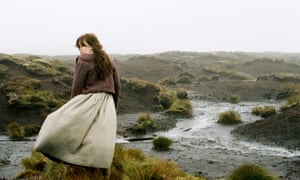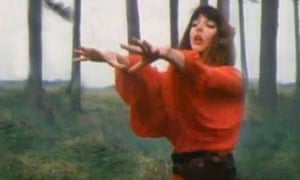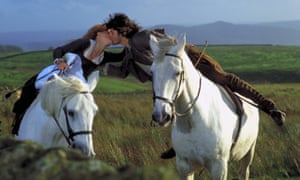The strange cult of Emily Brontë and the 'hot mess' of Wuthering Heights
Brontë was no romantic child of nature but a pragmatic, self-interested Tory. Why is she still adored for her ‘screeching melodrama’ of a novel?Kathryn Hughes
21 July 2018
Over this ecstatic high summer, visitors to the Haworth parsonage museum will be able to watch a film that simulates the bird’s-eye view of Emily Brontë’s pet hawk, Nero, as he swoops over the moors to Top Withens, the ruined farmhouse that is the putative model for Wuthering Heights. You’ll be able to listen to the Unthanks, the quavery Northumbrian folk music sisters who have composed music in celebration of Emily’s 200th anniversary. If that’s not enough, you can watch a video installation by Lily Cole, the model-turned-actor-turned-Cambridge-double-first from Devon, which riffs on Heathcliff’s origins as a Liverpool foundling. Finally, Kate Bush, from Kent, has been busy on the moors unveiling a stone. In short, wherever you come from and whoever you are, you will find an Emily Brontë who is sufficiently formless yet endlessly adaptive to whatever you need her to be – a rock, a song, a bird in flight.
That’s assuming, of course, that you are female. Nearly all the activities mentioned in connection with the forthcoming anniversary of her birth on 30 July involve women as makers, demonstrators, celebrators and educators. Likewise, nearly all Emily Brontë’s biographers and scholars over the past century have been women. If you do spot a man in the mix, chances are that he has been shuffled off to the side, rather like Branwell Brontë, though hopefully without the urge to get drunk and set fire to himself. The only other author who has become the object of such an intense female pash in the last 200 years is Sylvia Plath, who happens to be buried less than 10 miles away from Haworth at Heptonstall. The parallels are uncanny. Separated by a century, both Brontë and Plath were poets who remain most famous for writing a single intensely autobiographical novel. There’s even a pleasing bit of intertextuality in the way that in 1956 Sylvia Plath actually managed to marry Heathcliff in the form of her own glowering man-of-the-moors, Ted Hughes. Together the newlyweds tramped up to Top Withins and wrote poems about it, an event that Hughes was still mulling over 40 years later in his valedictory Birthday Letters. Both Plath and Brontë died at the age of 30 and then only gradually started to attract the cult-like devotion of female fans, who responded rapturously to their heroines’ status as exiles from the twin kingdoms of heteronormative happiness and literary fame.
This last point might seem odd in the case of Brontë who, as the 20th century began, was beginning to overtake her elder sister Charlotte as the most popular of the “three weird sisters” (a Ted Hughes coinage). But while it’s true that Brontë was increasingly important to a growing body of female readers who were claiming her as a proto-feminist New Woman, she was a long way from being admitted to the literary canon. In 1948 FR Leavis explicitly excluded her from The Great Tradition –his book celebrating English novelists who actually matter – by arguing that Wuthering Heights was nothing but “a kind of sport”, which is an odd way of describing a novel in which no one cracks a smile. Of course, if Leavis had put Emily Brontë on his prize winners’ podium, he’d have spoiled the fun that comes with passionately rooting for an outsider. George Eliot, who was one of the few women to make Leavis’s lineup, may be admired, but she is hardly worshipped in the same way as Brontë. Next year is Eliot’s bicentenary, yet it’s hard to imagine the Unthanks offering to come up with a tune.
But was Emily Brontë really such a finely tuned instrument, exquisitely alert to the psychic vibrations around her? For four brief months in 1842 she was employed to give piano lessons to three sisters by the name of Wheelwright. Despite her pupils’ sturdy-sounding surname, the setting was not Yorkshire but Brussels, where all the young women attended the Pensionnat Heger, one of the best schools in the city. Technically, 24-year-old Brontë was a student-teacher, earning her board and tuition by providing music tuition to the smaller girls. But when it came to deciding the timing of the lessons, Miss Brontë was careful to arrange things to suit herself. Refusing to break into her own precious study time, she insisted on receiving her pupils only once the school day was over. The result, reported the oldest sister Laetitia, was the sight of three girls ranging from six to 10 years old emerging from the music room in tears at having lost so much of their playtime. Fifty years later Laetitia Wheelwright was still recalling Emily matter of factly: “I simply disliked her from the first.” Not “hated”, not even “snarled”, “growled” or “foamed at the mouth”, which is how the characters in Wuthering Heights let you know they are feeling cross. No, what Laetitia experienced was a cold, enduring “dislike” towards an adult woman who put her own needs above those of the children she was paid to teach.
This Emily Brontë – self-interested, pragmatic and stonily indifferent to her moral responsibilities – is not the one the literary heritage industry will be celebrating later this month. I have never understood the cult of St Emily of Haworth. Indeed, I have spent a reading lifetime struggling to get to the end ofWuthering Heights, the screechy melodrama about two families living on the Yorkshire Moors who inter-marry, squabble, die, buy land, lose land, beat each other up and have children to whom they give bafflingly identical names. In this bafflement I am in good company. Virginia Woolf who, along with Sylvia Plath, thought it a sacrilege to scribble in her books, broke her rule with Wuthering Heights, sketching out a family tree on a blank page, in a desperate attempt to sort out how all those multiple Catherines, Heathcliffs and Lintons fit together. Part of the problem, of course, is that they all sound the same, speaking at a hysterical pitch, as if straining to make themselves heard over a permanent gale.
This abiding feeling that Wuthering Heights makes too much noise and not enough sense was woven into my first encounter with the book. Long before I was old enough to read it, I watched the Monty Python sketch in which Catherine and Heathcliff exchange passionate declarations of adulterous love across the moor tops using semaphore. Without quite understanding how, I was being inculcated into the view that this was a text where characters spoke with wild, repetitive exuberance yet communicated nothing that couldn’t be conveyed with a couple of crisp waves of a flag: “Oh Catherine!” “Oh Heathcliff!” After that they seemed to run out of steam.
Again, I turn out to be in good company. The reviews, when they appeared following publication in December 1847, comprised the sort of chorus of disapproval that would send most debut authors into a funk. While several reviewers acknowledged that the book had a strange sort of “power”, all of them proceeded to shred it to pieces. “The incidents are too coarse and disagreeable to be attractive,” said the man from the Spectator. “It is wild, confused, disjointed, and improbable,” said someone else. “In Wuthering Heights the reader is shocked, disgusted, almost sickened,” complained Douglas Jerrold’s Weekly Newspaper. “How a human being could have attempted such a book as the present without committing suicide before he had finished a dozen chapters, is a mystery,” shuddered Graham’s Lady’s Magazine from the US. This was also the publication that wondered if the author, at this time still known as Ellis Bell, had simply been eating too much cheese.
We don’t know what Brontë made of the reviews, although some of them were found tucked away in her desk at her death a year later. What we do know is that Charlotte Brontë, who by the end of 1849 was the sole survivor of her siblings and the author of the commercially successful Jane Eyre, worried dreadfully about the reputational damage Wuthering Heights might do to the emerging Brontë brand. In a new preface to the 1850 edition ofWuthering Heights and Anne Brontë’s Agnes Grey, Charlotte revealed the true identity of Ellis Bell and included a defensive biographical sketch of Emily that would set the terms of her reception for the next 150 years.
In order to excuse the coarseness of Wuthering Heights, with its madness and perverse sexuality – elements that were also worryingly present in Jane Eyre– Charlotte turned Emily into an idiot savant, who “did not know what she had done”. Being “a native and nursling of the moors”, Emily had made a book that was “hewn in a wild workshop, with simple tools, out of homely materials”. The result was “moorish, and wild, and knotty as a root of heath”, an involuntary exhalation rather than an act of conscious creation. Bringing her apologia for her sister to a thundering climax, Charlotte concluded that Emily was “stronger than a man, simpler than a child, her nature stood alone”.
Just five years later Charlotte was dead too, but her characterisation of Emily as a freak of nature would gust down the decades, gathering sound and fury as it went. When the novelist Elizabeth Gaskell published her Life of Charlotte Brontë in 1857, she took Charlotte’s image of her sister as having an entirely original “nature” and scaled it up to fantastic proportions. Now Emily, whom Gaskell had never met, became “a remnant of Titans”. By this Gaskell wasn’t referring to the fact that Emily was the tallest person in the parsonage, with the exception of the Rev Brontë. What she was trying to get at was the sense that Emily was both mythic and a shape-changer, unbound by the physical laws of the universe. It is this that you now see playing out at Haworth, where Emily’s soul has migrated temporarily into the body of her pet hawk.
The insistence on defining Emily Brontë as a natural rather than a cultural phenomenon encountered no serious pushback until the 1990s. At that point a new wave of revisionary scholarship suggested that, far from being a remote and primitive hovel as Gaskell suggested, Haworth was a busy cultural centre with a keen curiosity about and attachment to what was going on in the world. There were newspapers, concerts and lectures. What’s more, the little family at the parsonage was tied in to the latest literary developments, thanks to the three heavyweight periodicals – Blackwood’s, Fraser’s Magazine and the Edinburgh Magazine – which they read each month. The bookshelves held an expansive range of literary classics. It was exactly the kind of intellectual habitat you might expect of Rev Patrick Brontë, a man who 40 years earlier had made the quite extraordinary leap from tending a blacksmith’s forge in rural County Down to reading theology at St John’s College, Cambridge simply by virtue of being very clever indeed.
Far from writing “from the impulse of nature” and “the dictates of intuition” as Charlotte would have it, Emily Brontë was a richly resourced and highly self-conscious literary artist. In particular she was steeped in second-wave Romanticism, which she knew from her father’s fine collection of work by Shelley, Scott and Byron. Another, complementary, set of references came from the mystery and horror of German Romantic literature, which she read in the original. For while the little Wheelwrights were crying their eyes out, Emily was busy poring over her German grammar and reading spooky gothic tales by the likes of ETA Hoffmann. If Wuthering Heights struck contemporary critics as unrecognisably strange, it was only because then, as now, people had very short literary memories. In an age when Gaskell was gearing up to write her Condition of England novels, with their close attention to economic and social injustice in the industrial north, Brontë’s attachment to older gothic models (Mary Shelley’s Frankenstein is an obvious one to set alongside Hoffmann) came over as strikingly odd. It wasn’t thatWuthering Heights was shockingly avant garde so much as wilfully retro, just like the deeply unfashionable clothes that Emily insisted on wearing in Belgium, despite the derisive sniggers of her more sophisticated classmates.
Personally, I can’t see how either the “suckled by wolves” or “literary historian” narrative helps to make Brontë more palatable. This, after all, is the girl who, on the evidence of Wuthering Heights, seems to have considered hanging a small dog an act of sexy foreplay. If you want to find a way of redeeming her I would suggest that it lies not in explaining away her raging unlikability but in thinking of it as a kind of performance art situated within a very particular social and economic context. Brought up at a time when the daughters of poor clergy were expected to squeeze themselves into tiny spaces dictated by other people’s needs – as caregivers to elderly relatives, as governesses to the young, as the harried wives of impoverished curates – she simply refused to comply. While her sisters trudged out to work as governesses and hated nearly every minute of it, Emily lasted just six months as a schoolteacher, souring the mood irrevocably when she told her pupils that she was fonder of the house dog than she was of them. She also, and this seems like the final touch of unpleasantness, became testy with her sisters when they dared to complain about the awfulness of having to earn their keep by living with strangers.
Having talked (or rather, not talked – she used silence to bully) her way out of paid employment, Brontë contrived to return to where she had wanted to be all along – at home in Haworth. Despite there being two servants to look after the modestly sized parsonage and one modestly sized parson, Emily made a case for needing to be onsite as an extra housekeeper. And to offset her lack of income, she became an expert financial investor, studying newspapers to ensure that the family’s modest savings were placed in the best-performing railway stocks. She was cannily alert, too, to the way that the literary market worked. When the Brontës’ first book, a joint collection of poetry, sold only a handful of copies, she was quick to turn to the much more profitable genre of fiction, in the same way that Plath self-consciously set out to write a “potboiler” of a novel – The Bell Jar – as a break from the slow and thankless business of trying to sell her verse.
Victorian women choosing to duck the demands of domestic life to spend their time doing something they enjoyed is hardly a novel idea. Florence Nightingale and Elizabeth Barrett Browning used invalidism as a way to carve out time, space and mental freedom so that they could get on with reforming the Indian army and writing lyric verse respectively. The difference here is that Nightingale and Barrett were both from wealthy households that could easily afford the extra labour involved in supporting an adult woman in expensive, non-productive seclusion. The family at the parsonage enjoyed no such financial elasticity, which makes Brontë’s insistence on the right to abandon her economic obligations all the more audacious. There is a certain topsy-turvy irony too in the fact that, unlike Nightingale and Barrett, Brontë was actually pretty sick. Yet she refused to use her rackety health as an excuse, instead throwing herself into strenuous physical domestic labour. Charlotte wrote sadly to her old friend Ellen Nussey that “to offer any help is to annoy … you must look on and see … her do what she is unfit to do, and not dare to say a word.” Even in her domestic rebellion Brontë managed to invert the usual terms. Not that she’d have seen it like that. Having lived through the dreadful industrial unrest of the 1830s and 40s, Emily remained sympathetic to a high Tory worldview (Charlotte used her as the model for her strike-smashing heroine Shirley). And if by time travel magic we could fast forward Brontë to the age of the suffragettes we would find her snorting in derision and, quite possibly, setting a large dog on the women in purple and green. In other words, Brontë is not on “our side” and were we to meet her, we would not like her.
And that, really, is the point. In the place of Emily Brontë the wuthery maiden of the moors, we need to put Emily Brontë the ruthlessly self-defined artist. I happen to hate that art – no many how many popularity polls it wins, and no matter how many literary critics point out how cleverly it is crafted, nothing will convince me that Wuthering Heights is anything but a hot mess. But the fact that it exists at all, written in such unpromising circumstances by a woman who was convinced of her right to produce it, has a certain magnificence. Emily Brontë is the patron saint of difficult women. For that alone, she is to be admired, if only grudgingly and from a safe distance.
- Making Thunder Roar: The Emily Brontë Bicentenary Exhibition is at the Brontë Parsonage Museum until January. bronte.org.uk.
- THE GUARDIAN
DE OTROS MUNDOS
Secretos de los libros únicos de un autor / Treinta eclipses memorables
Los escritores y sus enfermedades / Cuando el genio literario emerge del sufrimiento
Eduardo Berti / Las hermanas Brontë
El hermano Brontë y los otros olvidados
Emily Brontë / Cumbres borrascosas / Fernando Vicente
Emily Brontë / 200 años de desafío y vigencia de una autora clásica
Emily Brontë / 200 años de cumbres y versos
Las vidas ocultas de las Brontë
Andrea Arnold / Emily Brontë / Regreso a Cumbres borrascosas
Las oscuras pasiones de Emily Brontë
DRAGON
The 100 best novels No 13 / Wuthering Heights by Emily Brontë (1847)
My hero / Lucasta Miller on Emily Brontë
Emily Brontë may have had Asperger syndrome, says biographer
Emily Brontë / Melding fantasy and realism in Wuthering Heights
Why those subversive Brontë sisters still hypnotise us
The strange cult of Emily Brontë and the 'hot mess' of Wuthering Heights
Lily Cole / Why I made a film about 'violent, awful' Heathcliff
Brontë’s Lovers, Facing Even More Storms
Secretos de los libros únicos de un autor / Treinta eclipses memorables
Los escritores y sus enfermedades / Cuando el genio literario emerge del sufrimiento
Eduardo Berti / Las hermanas Brontë
El hermano Brontë y los otros olvidados
Emily Brontë / Cumbres borrascosas / Fernando Vicente
Emily Brontë / 200 años de desafío y vigencia de una autora clásica
Emily Brontë / 200 años de cumbres y versos
Las vidas ocultas de las Brontë
Andrea Arnold / Emily Brontë / Regreso a Cumbres borrascosas
Las oscuras pasiones de Emily Brontë
DRAGON
The 100 best novels No 13 / Wuthering Heights by Emily Brontë (1847)
My hero / Lucasta Miller on Emily Brontë
Emily Brontë may have had Asperger syndrome, says biographer
Emily Brontë / Melding fantasy and realism in Wuthering Heights
Why those subversive Brontë sisters still hypnotise us
The strange cult of Emily Brontë and the 'hot mess' of Wuthering Heights
Lily Cole / Why I made a film about 'violent, awful' Heathcliff
Brontë’s Lovers, Facing Even More Storms










No comments:
Post a Comment